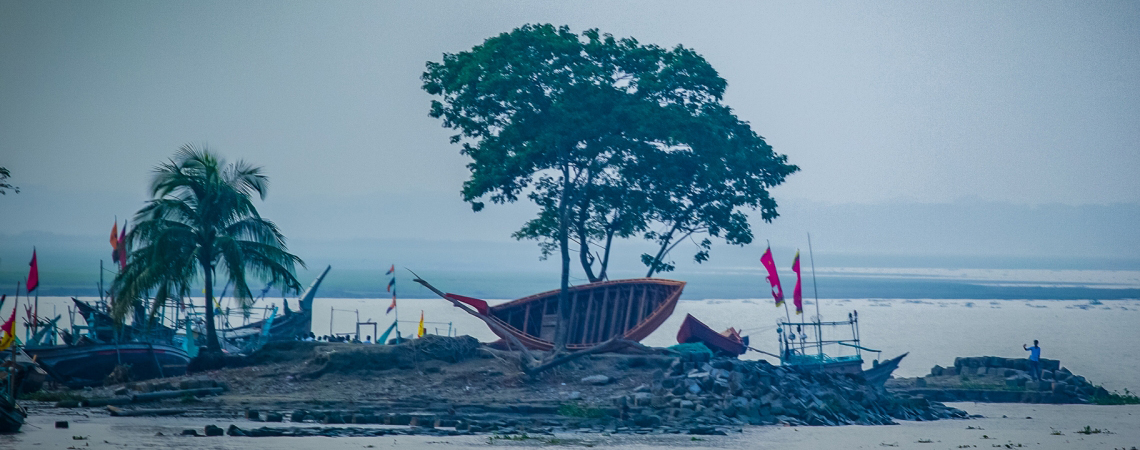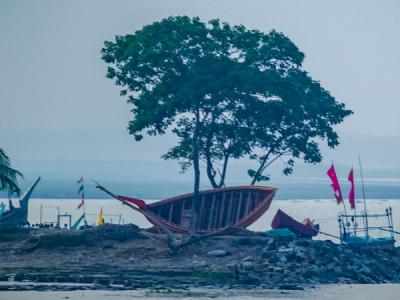
Photo:
Because of its geographical location, major rivers and low-lying deltaic terrain, Bangladesh is highly exposed to the impacts of both slow and rapid-onset climate-driven disasters, including sea-level rise, saline intrusion, cyclones, storm surges, floods, extreme heat and droughts.
Its vulnerability is increased by local dependency on agricultural livelihoods - agriculture in Bangladesh still provides employment to over 43% of the country’s workforce and 60% of all employed women - and low adaptive capacity within the government and communities. Char (island) communities face a particularly high level of exposure to natural disasters.
Led by the Ministry of Environment, Forest and Climate Change, with technical support from UNDP, the five-year project Adaptation Initiative for Climate Vulnerable Offshore Small Islands and Riverine Charland in Bangladesh will:
- Roll out cyclone and flood-resistant homes and livelihood practices for vulnerable households living on the target chars (islands);
- Build and repair local infrastructure such as embankments, rainwater harvesting systems for safe drinking water and home-garden irrigation, and install community nano-grids for electrification;
- Improve cyclone preparedness and response, including risk mapping and expanded early warning systems; and
- Build the capacity of local and national government and communities in realising climate-resilient development on chars.
An estimated 341,000 people (31,000 direct beneficiaries and 310,000 indirect beneficiaries) living on chars in the districts of Rangpur and Bhola are expected to benefit.
- Community
- Municipality
- District
- National
- Country Office
- Local Governments
- National Governments
- Non-Governmental Organizations
- Private Sector Partners
- United Nations Development Programme (UNDP)
- Adaptation Fund
- Bangladesh Ministry of Environment and Forests
- United Nations Development Programme (UNDP)
Expected outcomes
Component 1. Enhanced climate resilience of households through climate-resilient housing, electrification and climate-proof water provisioning
Output 1.1. Cyclone and flood resilient houses for the most vulnerable households are supported.
Output 1.2. Community-level nano-grids installed for electrification to enhance adaptive capacity.
Output 1.3. Locally appropriate rainwater harvesting systems for safe drinking water and home-garden irrigation installed.
Component 2. Increased climate resilience of communities through climate-resilient infrastructure, climate risk mapping and inclusive cyclone preparedness.
Output 2.1. Climate-resilient infrastructure built to protect life and prevent asset loss.
Output 2.2. Embankments repaired and innovative model for community embankment management introduced.
Output 2.3. Climate-resilient investment on chars promoted through climate hazard maps and expanded cyclone early warning systems.
Output 2.4. Cyclone Preparedness Programme (CPP) modernised, made gender-responsive, and expanded to provide timely cyclone early warning and response at scale.
Component 3: Improved income and food security of communities by innovating and providing assistance to selected households for climateresilient livelihoods practices
Output 3.1 Climate-resilient agriculture implemented and supported at a community level.
Output 3.2 Diversified livelihoods developed and supported for the most vulnerable households.
Component 4. Enhanced knowledge and capacity of communities, government and policymakers to promote climate resilient development on chars
Output 4.1. Local government institutions are capable of climate risk-informed planning and implementation.
Output 4.2. Knowledge and awareness generated to promote climate resilient approaches and strategies.
Resources from the Adaptation Fund (AF) will be invested in four components. Firstly, it will assist households to enhance the resilience of their houses and livelihoods to climate change-induced flooding, cyclones, saline intrusion and droughts. Secondly, it will improve community-level infrastructure, including embankments with modern climate-resilient technology and effective local management practices. Thirdly, it will assist the Bangladesh Cyclone Preparedness Programme (CPP)1 under Disaster Management Department, to enhance its activities in the remote coastal char targeted by the project, in order to provide timely early warnings and effective emergency response. This will be done by expanding the programme’s coverage in the area, modernising its equipment, and making it fully gendersensitive. Finally, the technology, approaches and knowledge generated by the project will be used to build the capacity of the local and national government; and communities to make climate-resilient investments and policies.
The project will address the knowledge technical, financial and institutional barriers to climate-resilient housing, infrastructure and livelihoods, with interventions benefiting an estimated ~341,000 people (~31,000 direct beneficiaries and 310,000 indirect beneficiaries) living on chars in the districts of Rangpur and Bhola. Spanning over five years, the project will be implemented by the Ministry of Environment, Forest and Climate Change following UNDP’s National Implementation Modality.
The project will contribute towards the achievement of the Government of Bangladesh’s national priorities as outlined in the Bangladesh Climate Change Strategy and Action Plan (BCCSAP) and Nationally Determined Contribution (NDC). Six of the ten near-term areas of intervention identified by the first NDC will be addressed by the project, namely: i) food security, livelihood and health protection, including water security; ii) comprehensive disaster management; iii) coastal zone management, including saline intrusion control; iv) flood control and erosion protection; v) climate-resilient infrastructure; and vi) increased rural electrification. Furthermore, the project is directly aligned with seven of the fourteen broad adaptation actions prioritised by the first NDC, namely: i) improved early warning systems; ii) disaster preparedness and shelters; iii) protection against tropical cyclones and storm surges; iv) provision of climate-resilient infrastructure and communication; v) provision of climate-resilient housing; vi) stress-tolerant crop variety improvement and cultivation; and vii) capacity building at individual and institutional level to plan and implement adaptation programmes and projects.
This project has been developed through extensive stakeholder consultations, including with communities in the selected islands, civil society and with the GoB (see Annex C). The design of the project has been reviewed as per the Government of Bangladesh’s internal process, led by the Adaptation Fund Designated Authority and involving relevant government ministries.
-
Component 1. Enhanced climate resilience of households through climate-resilient housing, electrification and climate-proof water provisioning
Output 1.1. Cyclone and flood resilient houses for the most vulnerable households are supported.
Output 1.2. Community-level nano-grids installed for electrification to enhance adaptive capacity.
Output 1.3. Locally appropriate rainwater harvesting systems for safe drinking water and home-garden irrigation installed.
Component 2. Increased climate resilience of communities through climate-resilient infrastructure, climate risk mapping and inclusive cyclone preparedness.
Output 2.1. Climate-resilient infrastructure built to protect life and prevent asset loss.
Output 2.2. Embankments repaired and innovative model for community embankment management introduced.
Output 2.3. Climate-resilient investment on chars promoted through climate hazard maps and expanded cyclone early warning systems.
Output 2.4. Cyclone Preparedness Programme (CPP) modernised, made gender-responsive, and expanded to provide timely cyclone early warning and response at scale.
Component 3: Improved income and food security of communities by innovating and providing assistance to selected households for climateresilient livelihoods practices
Output 3.1 Climate-resilient agriculture implemented and supported at a community level.
Output 3.2 Diversified livelihoods developed and supported for the most vulnerable households.
Component 4. Enhanced knowledge and capacity of communities, government and policymakers to promote climate resilient development on chars
Output 4.1. Local government institutions are capable of climate risk-informed planning and implementation.
Output 4.2. Knowledge and awareness generated to promote climate resilient approaches and strategies.
Monitoring and evaluation will examine the impact, outcomes, processes and activities of the project with key evaluations undertaken and the start and on a quarterly basis, with an annual Project Performance Report (PPR) delivered to the donor each year.
Periodic monitoring will be conducted through site visits by the UNDP Country Office and the UNDP RCU, based on the agreed schedule in the project's Inception Report/Annual Work Plan, to assess first-hand project progress.
The project will undergo an independent Mid-Term Evaluation at the mid-point (in the third year) of project implementation.
An independent Final Terminal Evaluation will take place three months prior to the final Project Board meeting and will be undertaken in accordance with UNDP and Adaptation Fund guidelines.
- Karma RaptenRegional Technical Advisor, Climate Change Adaptation, UNDP
- Arif Mohammad FaisalProgramme Specialist, UNDP Bangladesh


